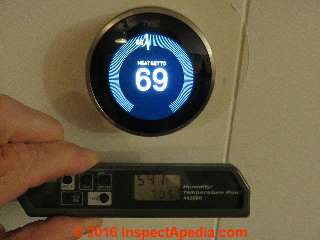 Accuracy of Nest Room Thermostat Humidity Indicator
Accuracy of Nest Room Thermostat Humidity Indicator
What affects the accuracy of humidity measurements
- POST a QUESTION or COMMENT about humidistats, humidity measurement accuracy, Nest thermostat humidity reading, & heating and air conditioning thermostat operating properties
Accuracy of the Nest thermostat's humidity reading and accuracy of other room humidity measurements:
How accurate is the humidity reading provided by the Nest room thermostat and what conditions affect the accuracy of any room thermostat or humidistat?
This article series explains in detail the diff rent types of sensors used in heating and cooling room thermostats and how heating or air conditioning thermostats actually work. We explain how a thermostat works in response to room temperature, humidity, and other conditions. These articles will help repair technicians and building occupants to understand wall thermostats, their use, setting, and adjustment.
Page top photo: measuring relative humidity at the building wall where a Nest 3 room thermostat has been installed.
InspectAPedia tolerates no conflicts of interest. We have no relationship with advertisers, products, or services discussed at this website.
Room Thermostat or Humidistat Accuracy & Response to Indoor Humidity
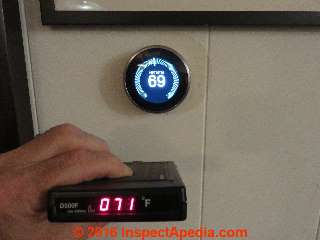 Reader Question: humidity & temperature in room vs. in wall vs. Nest thermostat response
Reader Question: humidity & temperature in room vs. in wall vs. Nest thermostat response
2016/08/22 Anonymous wrote [by private email]
Can you tell me what the difference in humidity % in the house would be as opposed to inside the wall?
It seems the portable dehumidifier is reading 45%, but their Nest thermostat is saying 76% (the nest may be reading the humidity from behind it , inside the wall)?
[Click to enlarge any image]
At page top I'm measuring the relative humidity at the wall next to a Nest 3 thermostat installed on an interior wall. In the photo shown here I'm measuring approximate wall temperature just below the thermostat.
Reply: wall conditions and thermostat location affect humidity readings made by the Nest thermostat and other thermostats and humidistats
Thanks for the good question. Yes the wall conditions and thermostat location would be expected to affect humidity readings made by the Nest thermostat. Generally room thermostats are less accurate than lab-grade test instruments, but their performance in accurately measuring conditions immediately around the thermostat is pretty good, often in the +/- 1% range.
All wall thermostats, not just Nest units, can be significantly affected by conditions within and on the other side of the wall to which the thermostat is mounted. Thermostat behavior and readings of temperature, and in the case of Nest, humidity, are also significantly affected by better-known external conditions such as
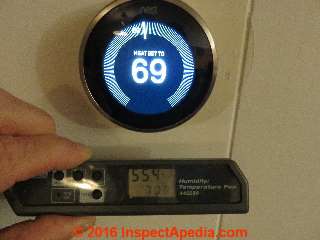
- The thermostat mounting location
- Exposure to air currents, dra5fts, sunlight
- For forced warm air or cooling systems, exposure to air flow from a supply duct
- Wall temperature and humidity where the thermostat is mounted
Room thermostats are also affected by heat gain or loss through the wall upon which the thermostat is mounted. Our page top photograph shows a Nest 3 room thermostat mounted on a kitchen wall. This is a wood-stud framed hollow interior wall with no insulation in the wall cavity.
On the other side of this wall is the hydronic heating boiler that heats this home, and not-shown in the photograph is a wall-mounted heating convector closer to the floor below this thermostat. Heat transmitted through this wall from the boiler room keeps the wall warmer than other areas in the area of the home that the thermostat serves.
As a result, during the heating season the room heated under control of this thermostat will always be cooler than the temperature reported by the thermostat.
Just above I'm repeating the same measurement in the same location with the same instrument, minutes after the first measurement shown at page top. You'll see that the RH measurement changed from 54.1% to 55.4% and the temperature reading changed from 70.5°F to 70.8°F. These modest measurement variations are normal.
For a more accurate temperature measurement using infrared monitors such as this Exergen hand-held device I'd have to measure a blackened surface.
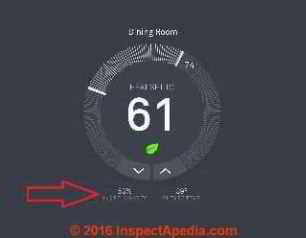 Preceding photo: this Nest thermostat information screen is produced by accessing your Nest thermostat from a smartphone or from a computer.
Preceding photo: this Nest thermostat information screen is produced by accessing your Nest thermostat from a smartphone or from a computer.
Our red arrow points to the room humidity indicated by this Nest thermostat mounted in the kitchen of a New York home, read by the author while working in Mexico.
[Click to enlarge any image]
This is the same Nest thermostat illustrated in the on-site photographs above on this page. The device is reporting an indoor humidity of 58%.
- Air currents within the wall cavity on which the thermostat is mounted
In some buildings with hollow wood or steel-stud-framed walls, I was surprised to sometimes find significant air currents within wall cavities.
There are two types of such air movement. In some buildings where there are openings at the wall top, say from holes drilled for wiring or plumbing or in modular construction where an inch or more may be spacing marriage walls apart, convection currents may move air from a basement or crawl space all the way up into an attic and onwards out of the building through roof vents.
Even within a rather well-sealed hollow wall cavity there can be convection currents circulating air within a wall due to heating effects of sun on parts of a wall or differences in room temperature at different heights above the floor.
- Other conditions affecting thermostat behavior are detailed
at TEMPERATURE RESPONSE of ROOM THERMOSTATS
All of these can impact the reading of a wall thermostat. Thermostat designers know this. Modern thermostats mostly use a small thermistor that is located "in free air" near an edge of the thermostat and spaced a bit away from the wall surface. That design helps the thermostat record room temperature but by no means does it leave the thermostat immune to the other effects I've described.
With that general arm-waving explained, yes your Nest thermostat's reading of humidity is affected by the wall and wall interior.
In some of the thermostat installation photos I've posted you'll see that I took pains to completely seal the wall opening behind the thermostat, leaving just the wires exposed through joint compound or Dash Patch that filled the hole. I stuffed a bit of news print through the hole to make patching it easier. I've read that Nest support also recommends closing the wall opening behind their thermostat.
Studying air movement in buildings and also temperature and humidity variation I've found a rather wide range of measurement results even by just where within a room a sensor is placed.
The extent of that variation is significantly affected in turn by the amount and distribution of air movement. For example using a simple relative humidity measuring tool I find quite a different humidity in the center of the room than by its various walls as well as different humidity (and temperature of course) at different elevations above the floor.
Wall composition also affects thermostat readings. For example, the thermal mass of a solid masonry wall is likely to cause a thermostat mounted thereon to respond to room temperature changes more slowly than would the same thermostat mounted on a hollow core stud-framed wall. Similarly a solid masonry wall's thermal mass may lead to significantly higher humidity readings (and relative humidity readings) close to the wall surface than would be read in the center of the same room.
Starting with the Nest 2 the thermostat supported connection to a whole house dehumidifier or humidifier. The Nest 3 Thermostat technical specifications list "Humidity" among its sensors and readings but does not risk any statement about the accuracy of that readout nor even if we're reading absolute versus relative humidity.
Using the Nest 2 or Nest 3 Thermostat to Control a Whole House Humidifier or Dehumidifier
For the Nest 2 the company states:
Some whole-home humidifier or dehumidifier systems connect to the thermostat with one wire, while others have two. If yours has two wires, a professional installer may need to add a relay to convert it to one wire. - source: https://nest.com/support/article/How-do-I-set-up-Nest-to-work-with-my-whole-home-humidifier-or-dehumidifier retrieved 2016/08/22
For the Nest 3 the company also notes in the product's technical specifications:
Note: Only one of the wires that go in the connector (HUM, DEHUM, E, W3) can be connected to the Nest Thermostat. If you have dual fuel or a whole-home humidifier/dehumidifier, we strongly recommend that you use professional installation. - source: https://nest.com/support/article/3rd-generation-Nest-Thermostat-technical-specifications retrieved 2016/08/22
Ultimately a room thermostat can only read the temperature (and for Nest humidity) in the immediate area around the thermostat and those readings will also be affected by the mounting wall, thermostat location and the other room and air movement conditions I've discussed.
These variables are why, when drying out a damp or wet area in a building, I recommend locating the dehumidifier as centrally as possible in the space and supplementing its effectiveness by using box fans (or any fans available) to increase air circulation within the space. The improvement in dehumidification rate will be dramatic.
See these InspectApedia.com articles and the Nest specifications for more about controlling indoor humidity and temperature:
- HUMIDIFIERS & HUMIDITY TARGET
- HUMIDITY MEASUREMENT INSTRUMENTS
- TEMPERATURE RESPONSE of ROOM THERMOSTATS
- THERMISTORS
- THERMOSTAT CALIBRATION
- Nest 3 Thermostat Technical Specifications at this Nest.Com web page: https://nest.com/support/article/3rd-generation-Nest-Thermostat-technical-specifications
Sensors on room thermostats can also be affected by accumulated dust and debris. Our photo (below) shows a thermistor used in a room thermostat. We had to take the thermostat apart and use our lab microscope to take this photo - this is a detail you won't normally see when installing a room thermostat. But it's there.
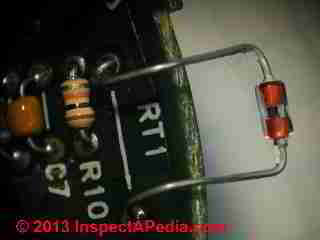
Thermostats control within a narrow range, say +/1 1 °F by using a thermistor combined with a high gain amplifier to obtain sensitivity down to 0.005oC!. What about reliability? Thermistors, properly selected for the environment, can be quite durable. Nevertheless, some thermostats or HVAC equipment include a "safe-default" operating mode to keep the system working in the event that the thermistor should fail.
Thermistor details such as how they work, definitions of types, features, and more photographs of thermistors are
at THERMISTORS.
Reader Comments, Questions & Answers About The Article Above
Below you will find questions and answers previously posted on this page at its page bottom reader comment box.
Reader Q&A - also see RECOMMENDED ARTICLES & FAQs
Question: why won't my outside A/C unit turn on?
why wont my outside unite turn on - Anon 7/30/11
Reply:
Anon, start your diagnostic procedure
at DIAGNOSTIC GUIDE A/C or HEAT PUMP
Question: Our A/C is running but not cooling the house - hot air comes out of the vents
question...Our air conditioning system is running, but not cooling the house. Only hot air is coming out of the vents. Can you tell me how I would know if it's the coil or the something in the unit outside - Vickie Ivie 7/13/11
Reply:
Vickie if you have good airflow but it's not cool, then the indoor air handler is working but the system is not cooling the air; assuming that the outside compressor/condenser is actually running (you should check) you could be out of refrigerant (a leak to find and fix) or there could be a control problem. See the diagnostic link I gave to Anon just above. Also
see REFRIGERANT GASES & PIPING.
Question: why does the blower fan run when the thermostat is OFF?
Why is my blower fan coming on when the dual thermostat is in the off position. - Charles 11/29/11
Reply:
Charles, see Fan won't stop: What to do if the Air Conditioning or Heating System Blower Fan Runs Continuously and Won't Shut Off? for possible explanations; also look for a defrost cycle control or control board problem on your system. Charles there also could be some confusion between turning the A/C or cooling system off and turning the heating system off. Your system may be using the same blower assembly for both modes.
Question: Why does my AC system switch from cooling to emergency heat?
Why does my ac switch from cooling to emergency heat? You can't turn it off with the thermostat. Never had this problem until we had a digital thermostat installed? - Brenda 6/25/2012
Reply:
Brenda, I'd ask for a diagnostic service call by an experienced HVAC tech - I'm not sure what's going on - if the system is not running through some odd defrost cycle then perhaps there is a control board problem in the unit.
Question: my A/C won't turn off - reclaimed refrigerant and reloaded it
If my a/c will not shut down and I changed out my thermostat 3 times and it still will not shut down also reclaimed all the freon from unite clean it out and reloaded it - Andy 09/26/12
Reply:
Andy, check for a bad contactor switch.
Changing the same part repeatedly is probably not a reliable repair approach and suggests we're barking up the wrong tree. Unless at the changeout you also repeat a wiring area or part error.
Also, "reclaiming and reloading" refrigerant sounds odd to me. First because I'm not sure why you think this has to do with the A/C not shutting down and second because I wonder how, unless you're a trained HVAC rep, you'd have the equipment to properly reclaim refrigerant, and even if "reclaimed" I have no idea if the refrigerant is clean, doesn't have air mixed in with it, nor if you knew to install the proper charge.
Certainly if your system cannot reach the thermostat's SET temperature it will keep running. There could be a variety of reasons for not reaching the SET temp, including improper refrigerant charge.
Question:
(Mar 24, 2014) norm williams said:
have an olsen furnace that kicks on and off continuously, the forced air coming into the room is cool not hot, a thermometer reading 25 read 20 after holding it in front of the vent supposedly blowing hot air. it feels cold not hot. why is that?
Reply:
Norm,
It's time for a heating service call by a trained service technician. From what you describe it sounds as if the fan limit switch is not working properly; normally a forced warm air furnace blower doesn't turn on until the plenum is adequately warmed. Look also for leaks or disconnects in the ductwork or ducts routed through a cold area.
...
Continue reading at NEST LEARNING THERMOSTATS - topic home, or select a topic from the closely-related articles below, or see the complete ARTICLE INDEX.
Or see these
Recommended Articles
- ACCURACY vs PRECISION of MEASUREMENTS
- HUMIDITY CONTROL & TARGETS INDOORS
- HUMIDITY LEVEL TARGET
- HUMIDITY MEASUREMENT INSTRUMENTS
- TEMPERATURE RESPONSE of ROOM THERMOSTATS
- THERMOSTAT WIRING OPENING SEAL - how to improve the accuracy and response of a wall thermostat by sealing wall leaks
- THERMISTORS
- THERMOSTAT DIAGNOSTIC GUIDE
Suggested citation for this web page
HUMIDITY RESPONSE, NEST THERMOSTATS at InspectApedia.com - online encyclopedia of building & environmental inspection, testing, diagnosis, repair, & problem prevention advice.
Or see this
INDEX to RELATED ARTICLES: ARTICLE INDEX to HVAC THERMOSTATS
Or use the SEARCH BOX found below to Ask a Question or Search InspectApedia
Ask a Question or Search InspectApedia
Try the search box just below, or if you prefer, post a question or comment in the Comments box below and we will respond promptly.
Search the InspectApedia website
Note: appearance of your Comment below may be delayed: if your comment contains an image, photograph, web link, or text that looks to the software as if it might be a web link, your posting will appear after it has been approved by a moderator. Apologies for the delay.
Only one image can be added per comment but you can post as many comments, and therefore images, as you like.
You will not receive a notification when a response to your question has been posted.
Please bookmark this page to make it easy for you to check back for our response.
Our Comment Box is provided by Countable Web Productions countable.ca
Citations & References
In addition to any citations in the article above, a full list is available on request.
- [1] Proliphix Corporate Headquarters [Website: proliphix.com] , 3 LAN Drive Suite #100 Westford, MA 01886 Phone: +1.978.692.3375 Toll Free (U.S.): 866-IP-LIVING (866.475.4846)
- Sales: sales@proliphix.com Marketing: marketing@proliphix.com Customer support: support@proliphix.com http://www.proliphix.com/ - quoting from the company's website:
All Proliphix Network Thermostats come with our free Uniphy Remote Management Service. This unique offering lets you monitor and control your HVAC systems by simply pointing your Browser to our secure Proliphix Web Site. Enjoy the convenience of programming a thermostat from any location, using a simple graphical interface. No computer equipment or software is required. And since Proliphix takes care of the network configuration for you, you’ll be up and running in no time. We’ll even proactively monitor your thermostats and send you an immediate email or SMS message when an HVAC problem is detected. - [2] "The Nest Learning Thermostat", Nest Thermostat, 900 Hansen Way Palo Alto, CA 94304, Tel: 855-4MY-NEST, Email: info@nest.com, website http://www.nest.com/, retrieved 1/24/2013.
- [3] Honeywell Controls, the company wants you to use their contact form at this web page: http://www51.honeywell.com/honeywell/contact-support/contact-us.html
Honeywell Consumer Products, 39 Old Ridgebury Road Danbury, CT 06810-5110 - (203) 830-7800
World Headquarters, Honeywell International Inc., 101 Columbia Road, Morristown, NJ 07962, Phone: (973) 455-2000, Fax: (973) 455-4807 1-800-328-5111 - [4] White Rodgers Thermostats and HVAC controls,
Homeowner information: http://www.emersonclimate.com/en-US/brands/white_rodgers/Pages/wr-homeowner-info.aspx
Contractor information: http://www.emersonclimate.com/en-US/brands/white_rodgers/wr_contractor_info/Pages/white-rodgers-contractor-info.aspx
White Rodgers Product Catalog (don't misspell the company's name as White Rogers Thermostats) -
http://www.emersonclimate.com/Documents/thermostats.pdf - Thermostat Catalog - [5] Domestic Central Heating Wiring Systems and Controls, 2d Ed., Raymond Ward, Newnes, ISBN-10: 0750664363, ISBN-13: 978-0750664363, Quoting from Amazon.com:
This unique A-Z guide to central heating wiring systems provides a comprehensive reference manual for hundreds of items of heating and control equipment, making it an indispensable handbook for electricians and installers across the country. The book provides comprehensive coverage of wiring and technical specifications, and now includes increased coverage of combination boilers, recently developed control features and SEDBUK (Seasonal Efficiency of Domestic Boilers in the UK) boilers ratings, where known.
In addition to providing concise details of nearly 500 different boilers fuelled by electric, gas, oil and solid fuel, and over 400 programmers and time switches, this invaluable resource also features numerous easy-to-understand wiring diagrams with notes on all definitive systems. Brief component descriptions are provided, along with updated contact and website details for most major manufacturers. - [6] "Automatic Oil Burner Controls - Thermostats", Domestic and Commercial Oil Burners, 3rd Ed., Charles H. Burkhardt, McGraw Hill, 1969 (and later editions), ASIN B0000EG4Y8
- Hunter Fan 2500 Frisco Ave. Memphis, TN 38114 888-830-1326 www.hunterfan.com
- [7] Fuel Oil & Oil Heating Magazine, 3621 Hill Rd., Parsippany, NJ 07054, 973-331-9545
- [8] Domestic and Commercial Oil Burners, Charles H. Burkhardt, McGraw Hill Book Company, New York 3rd Ed 1969.
- [9] National Fuel Gas Code (Z223.1) $16.00 and National Fuel Gas Code Handbook (Z223.2) $47.00 American Gas Association (A.G.A.), 1515 Wilson Boulevard, Arlington, VA 22209 also available from National Fire Protection Association, Batterymarch Park, Quincy, MA 02269. Fundamentals of Gas Appliance Venting and Ventilation, 1985, American Gas Association Laboratories, Engineering Services Department. American Gas Association, 1515 Wilson Boulevard, Arlington, VA 22209. Catalog #XHO585. Reprinted 1989.
- [10] The Steam Book, 1984, Training and Education Department, Fluid Handling Division, ITT [probably out of print, possibly available from several home inspection supply companies] Fuel Oil and Oil Heat Magazine, October 1990, offers an update,
- [11] Principles of Steam Heating, $13.25 includes postage. Fuel oil & Oil Heat Magazine, 389 Passaic Ave., Fairfield, NJ 07004.
- [12] The Lost Art of Steam Heating, Dan Holohan, 516-579-3046 FAX
- Principles of Steam Heating, Dan Holohan, technical editor of Fuel Oil and Oil Heat magazine, 389 Passaic Ave., Fairfield, NJ 07004 ($12.+1.25 postage/handling).
- [13] "Residential Steam Heating Systems", Instructional Technologies Institute, Inc., 145 "D" Grassy Plain St., Bethel, CT 06801 800/227-1663 [home inspection training material] 1987
- [14] "Residential Hydronic (circulating hot water) Heating Systems", Instructional Technologies Institute, Inc., 145 "D" Grassy Plain St., Bethel, CT 06801 800/227-1663 [home inspection training material] 1987
- [15] "Warm Air Heating Systems". Instructional Technologies Institute, Inc., 145 "D" Grassy Plain St., Bethel, CT 06801 800/227-1663 [home inspection training material] 1987
- [16] Heating, Ventilating, and Air Conditioning Volume I, Heating Fundamentals,
- [17] Boilers, Boiler Conversions, James E. Brumbaugh, ISBN 0-672-23389-4 (v. 1) Volume II, Oil, Gas, and Coal Burners, Controls, Ducts, Piping, Valves, James E. Brumbaugh, ISBN 0-672-23390-7 (v. 2) Volume III, Radiant Heating, Water Heaters, Ventilation, Air Conditioning, Heat Pumps, Air Cleaners, James E. Brumbaugh, ISBN 0-672-23383-5 (v. 3) or ISBN 0-672-23380-0 (set) Special Sales Director, Macmillan Publishing Co., 866 Third Ave., New York, NY 10022. Macmillan Publishing Co., NY
- [18] Installation Guide for Residential Hydronic Heating Systems
- [19] Installation Guide #200, The Hydronics Institute, 35 Russo Place, Berkeley Heights, NJ 07922
- [20] The ABC's of Retention Head Oil Burners, National Association of Oil Heat Service Managers, TM 115, National Old Timers' Association of the Energy Industry, PO Box 168, Mineola, NY 11501. (Excellent tips on spotting problems on oil-fired heating equipment. Booklet.)
- [21] Trane TCONT800 Series Touch Screen Programmable Comfort Control Ownes Guide, American Standard, Inc., Troup Highway, Tyler TX 75711, January 2005, Telephone: Customer Service: 1-877-3381, website: www.trane.com
- [23] RTI Electronics. "NTC Thermistor Product Guide", 1999, RTI Electronics, Inc., 1800 E. Via Burton St., Anaheim CA 92806, Tel: 714-630-0081
- Our recommended books about building & mechanical systems design, inspection, problem diagnosis, and repair, and about indoor environment and IAQ testing, diagnosis, and cleanup are at the InspectAPedia Bookstore. Also see our Book Reviews - InspectAPedia.
- "Warm Air Heating Systems". Instructional Technologies Institute, Inc., 145 "D" Grassy Plain St., Bethel, CT 06801 800/227-1663 [home inspection training material] 1987
- Heating, Ventilating, and Air Conditioning Volume I, Heating Fundamentals,
- In addition to citations & references found in this article, see the research citations given at the end of the related articles found at our suggested
CONTINUE READING or RECOMMENDED ARTICLES.
- Carson, Dunlop & Associates Ltd., 120 Carlton Street Suite 407, Toronto ON M5A 4K2. Tel: (416) 964-9415 1-800-268-7070 Email: info@carsondunlop.com. Alan Carson is a past president of ASHI, the American Society of Home Inspectors.
Thanks to Alan Carson and Bob Dunlop, for permission for InspectAPedia to use text excerpts from The HOME REFERENCE BOOK - the Encyclopedia of Homes and to use illustrations from The ILLUSTRATED HOME .
Carson Dunlop Associates provides extensive home inspection education and report writing material. In gratitude we provide links to tsome Carson Dunlop Associates products and services.

